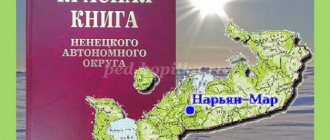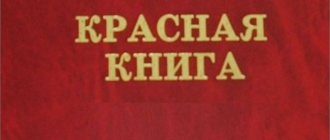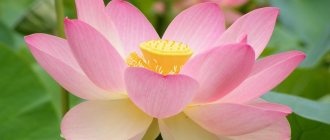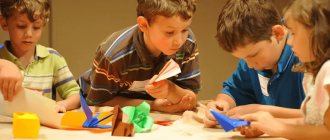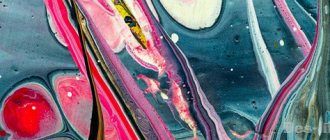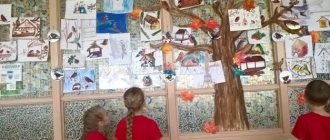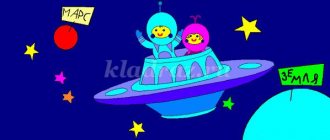Project “Do-it-yourself Red Book” in the middle group
Irina Pavlova
Project “Do it yourself Red Book” in the middle group
Tree, grass, flower and bird
They won't always be able to defend themselves.
If they are destroyed,
We will be alone on the planet!
Relevance of the project :
A preschool educational institution is the first link in the system of lifelong education; in preschool age, the foundations of personality are laid, including a positive attitude towards nature and the surrounding world. Love for nature, especially among children raised in urban environments, does not come on its own - it needs to be awakened. Preschool children show care and respect only for those objects of nature about which they have sufficiently deep and comprehensive knowledge. of the project “ Red Book ” was chosen.
to tell and explain to children what
the Red Book , why it is called red , what natural objects are protected and what needs to be done to preserve endangered species of animals, plants, and birds of our region. We need to teach children to behave correctly in nature and among people .
Project participants : children, parents, teachers.
Project type : educational and creative.
Project type : short-term (September-December)
The goal of the project : to familiarize preschoolers with the Red Book , to form a correct and humane attitude of the child towards the wildlife of his native land and the problems of its protection.
1. expanding children’s understanding of the diversity of nature;
2. formation of knowledge about animals and plants listed in the Red Book , the reasons for their extinction;
3. development of observation, curiosity, independent research skills;
4. the formation of such qualities as sympathy, empathy for all living things;
5. consolidating students’ knowledge about the rules of behavior in the natural environment ;
6. enrichment of vocabulary.
7. give an idea of the animals, plants, birds and fish included in
Red Book . Develop attention, memory, thinking. Arouse interest in the inhabitants of the steppe. Develop research skills.
1. Knowledge about the nature of the native land will expand, and on this basis a spiritual, ecological, moral, personal attitude to reality, a careful and responsible attitude towards the natural world will be formed.
2. Children will get acquainted with animals and plants listed in the Red Book ;
3. Creation of the Red Book for middle group No. 4 “Why”
4. Activating the position of parents as participants in the pedagogical process of a preschool educational institution.
Project implementation stages :
Preparatory stage. (September 2021)
• Identifying the relevance of the problem.
• Defining the goals and objectives of the project .
• Selection of encyclopedic and fiction literature about nature;
• Selection of information sources;
• Creation of visual and didactic material, handouts, presentations.
• Organization of a developmental environment in a group of older preschoolers (placement of reproductions of paintings, posters)
Main stage. (October-November 2021)
• conversations “Journey to the world of wildlife, “How to behave in nature”
,
"Be nature's friend"
.
• viewing paintings, albums, photographs;
• compiling descriptive stories based on paintings;
• discussion of problematic situations;
• solving riddles; singing songs;
•Didactic games: “Who lives where”
,
“Who Was Who”
,
“Name the Cubs”
,
“The Children Are Lost, Who Lives in the Forest”
,
“Good and Bad”
, etc.
•Reading fiction:
•Drawing: “Wild animals of the forests of Chuvashia”
,
"My favorite wild animal"
.
"Animals that live in the zoo"
.
•Coloring: “Wild Animals”
, stencils, templates.
•Reading fiction: Mikitov “Squirrels”
,
“On a forest road”
,
“In a den”
, V. Bianchi
“Bathing bear cubs”
G. Snegirev
“Trace of a deer”
, Russian folk tales:
“Tails”
,
“Fear has big eyes”
, M. I. Molyukov
“Bison”
(excerpt, A. A. Pleshakov
“Collection of fairy tales about animals”
.
• work with parents within the framework of the project .
Final stage (December 2021)
• Presentation of the author's red book
• Conducting a final event with children “Through the pages of the red book ”
• Children learned about rare animals that are listed in the Red Book ; about habits, lifestyle.
• Children's vocabulary has expanded and their horizons have expanded.
• Children have become more caring and respectful of the environment .
• Together, parents and children created the Red Book of Animals and Birds.
• Children have mastered some rules of behavior in nature.
We will continue to work in this direction together with children and parents.
Raising a patriot of one’s homeland is a responsible and difficult task, the solution of which only begins in preschool age.
A souvenir book for a lasting memory of childhood
Your mother's intuition will tell you how to make a book with your own hands as a keepsake. What would you like to keep forever, what cannot be erased from your memory, what pleasant moments can you capture?
You can continue the traditional album “Our Baby” with photographs of the first days of life, hand and foot prints, recordings of the first sounds and words.
The basis for creation can be:
- Children's drawings of different years of life,
- Crafts - appliqués, embroideries, hand engravings, photographs with the results of burning, design, etc.,
- Photos of a child from holidays, in elegant costumes or with his favorite toys.
Master class on assembling a lapbook “The Red Book”
Natalia Vazhenina
Master class on assembling a lapbook “The Red Book”
Master class on assembling a lapbook “ The Red Book ”
Print out the background. A4 format or 2 A4 sheets
We collect the envelope. All envelopes in this lapbook are folded in the same way.
Fold the edges of the envelope and glue the larger pieces together. Place the card with the corresponding icon inside and glue it to the background.
Cut out the environmental posters and glue them along the left side, applying glue to the white field. Glue them exactly on top of each other, the topmost one should be a poster without a white stripe.
Glue the resulting “book”
"Rules"
consist of two elements, fold the part with the text 4 times and glue
the “cover”
Cut out all three parts “ book ”
and bend each one in half
Trim edges if necessary. Glue to the background.
Cut and glue exactly on top of each other, respecting the edges. Glue only the left edge, about 1cm wide.
After assembly you should have such a cute Lapbook
All inspiration and success!
With respect to you and your work!
Children's master class “My Red Book” Since today the topic of ecology, endangered species of plants and animals is very relevant, the classes will focus on a thematic week. Lapbook “The Red Book” Good evening everyone! I decided to show you my lapbook “The Red Book”, which was made during the project “The Red Book of Nizhny Novgorod. Master Class. Making a lapbook “Winter” Master class. Making a lapbook “Winter”. Kokurina Rimma Yuryevna – teacher of MBDOU d/s No. 39, Arzamas. 2021 I present to you a master class. Master class on making a lapbook “We have fun playing and developing our fingers” Hello, dear colleagues! Let me present to your attention a master class on making a “lapbook” for the development of fine motor skills. Master class on making a lapbook “Spring” I bring to your attention the making of a lapbook on the theme: “Spring” What is a lapbook? Lapbook - literally translated from English means. Master class on making a laptop on the topic “Educational field “Music”” The laptop, which I want to present to the attention of educators, and especially music directors, is called “Musical Piggy Bank”. It is methodical. Master class on making a lapbook “Spring-Red” I am very glad that you visited my blog! Today I would like to present to your attention a master class on making a Lapbook on the theme “Spring-Red”. Master class on making a laptop “Health and Sports”. I bring to your attention material on healthy lifestyle, designed in the form of a laptop. Games, game exercises, riddles, poems, proverbs are placed in special ones. Master class on making a lapbook “Summer” Good day, dear colleagues. It's no secret that there are two working weeks left until summer, which means it's time to create.
Source
A simple version of homemade books
- If you have neither time nor energy, but there is an urgent need for a homemade book, you can limit yourself to basic skills and make it from 1-2 pages.
- You need to take an A4 sheet, fold the sides like doors, write text inside and place several drawings. Outside - draw stylized handles or windows.
- An ordinary postcard can also be considered a book. It is enough to write the name on the outside and make a drawing on the topic. There is printed text inside.
Do-it-yourself book templates are now sold in handicraft stores. They can be either blanks for writing and drawing - in the form of notebooks, notepads, with bindings or springs, or complete kits for making (with the alphabet, glue, brushes, etc.).
Lapbook “Red Book”
Nikulina Natalya
Lapbook “Red Book”
Good evening everyone! I decided to show you my “ Red Book lapbook , which was made during the “ Red Book of the Nizhny Novgorod Region” project.
Many people are already familiar with the concept of a lapbook , which is a folder with different pictures, pockets, windows on a given topic. And since the theme of our project was dedicated to the Red Book , then we decided to make a lapbook
And this is what we got.
Everyone knows that the Red Book has multi-colored pages. And I decided to make multi-colored pockets containing cards with images of animals, insects and plants.
Red pages.
During the project, we studied the Red Book of the Nizhny Novgorod region in great detail. We even made our own (see my blog)
.
And of course, in the lapbook I decided to make my own Red mini-book of our Nizhny Novgorod region. in the red book of our region. But to make it easier for children to understand what rare animals and plants there are in our area, I listed them on these signs.
«Red pages«
There is a map with the reserve and wildlife sanctuaries of our Nizhny Novgorod region.
There is a mini-book “Nature Conservation of the Nizhny Novgorod Region”.
During the project, we talked a lot with the guys about the rules of behavior in nature, and of course these rules found a place in the lapbook .
OK it's all over Now! Thank you for your attention!
“Red Book”, studying protected animals Red Book The work was carried out by the teacher of MDOU No. 15 “Alyonushka” NMR Izyumova T.P. One of the versions of the Red Book, made jointly. Children's master class “My Red Book” Since today the topic of ecology, endangered species of plants and animals is very relevant, the classes will focus on a thematic week. Lesson notes using ICT “Red Book of Russia” Lesson notes for the presentation: “Red Book of Russia”. Goals: To develop in children a caring and kind attitude towards their native nature. Shape.
For whom/what is the book being created?
You can make children's books with your own hands, taking into account the mandatory criteria:
- Child's age. You should not offer a finger book without text to a 5-year-old child - it is more suitable for a nursery group;
- Personal qualities of children. For those who are curious and already know how to read, a book without pictures is suitable.
- The main thing is that it should be interesting in topic or structure;
- The purpose of creation is for yourself and your family, to participate in a competition in kindergarten, for charitable purposes, as a gift for a friend or girlfriend, as a keepsake, etc.
A soft book made with your own hands will help you remember the moment of life forever.
Children grow up quickly, and soon such crafts will become a thing of the past. It’s worth making it, if only for the sake of being able to do it – for future grandchildren.
Reptiles
Approximately 70 species of animals represent the class of reptiles in the country. About 20 species are listed in the KKRF. They are common on the coast of water bodies and in forest areas.
Far Eastern skink
Far Eastern skink
The Far Eastern skink is a genus of lizards. Lizards live on Kunashir Island - near forests and on the river coast. The number is several thousand individuals. Predators such as minks and economic activities pose a danger to lizards.
Common copperhead
A representative of the colubrid family in Russia, it is distributed in the southern part of European territory. Copperheads swim well, but they try to avoid dampness, preferring dry meadows and clearings. The main diet consists of lizards.
Common copperhead
The danger for them comes from birds of prey, hedgehogs, rats, etc. Copperheads are also often mistaken for poisonous snakes. The main reason for the population decline is the use of pesticides in agriculture.
Gyurza
The viper is the largest representative of the genus of poisonous vipers. The most common in the South Caucasus (Transcaucasian viper). The main diet consists of rodents. It is considered a species whose numbers are declining. Currently there are about 1000 individuals. This happens mainly due to human activity.
Interesting: Common fox
